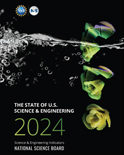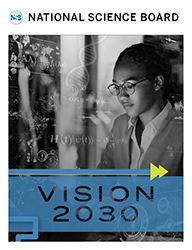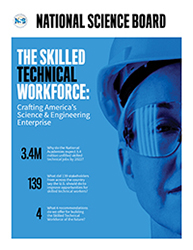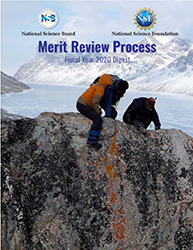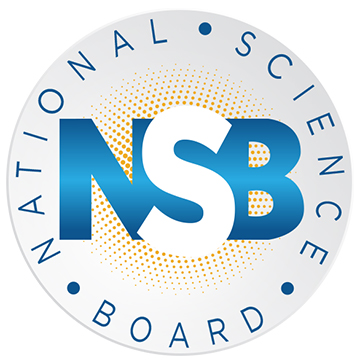
Two Intrepid Kentuckians and an Organization for Inventors Earn the Science and Society Award
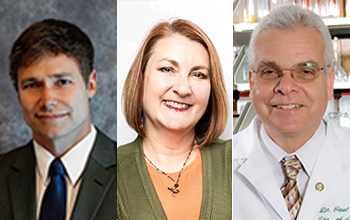
From L to R: Eric Wooldridge and Sheri McGuffin and NAI’s Paul Sandberg. (Credit and Larger Version)
April 18, 2024
ALEXANDRIA, Va. – The National Science Board is thrilled to recognize a pair of innovators and an organization dedicated to inventors for their extraordinary efforts to increase participation and diversity in the science and engineering fields and honor and support inventors, respectively.
The Board chose Sheri McGuffin and Eric Wooldridge for their successful effort to support and encourage people in Kentucky to join the STEM workforce and the National Academy of Inventors for its engaging and inclusive initiatives to strengthen and diversify the innovation economy.
The Science and Society Award honors individuals and groups that have made substantial contributions in the arts, media, education, or training programs to increase public understanding and appreciation of science and engineering in the United States.
Dan Reed, Chair of the National Science Board, will present the award to the awardees on May 1, 2024, during the National Science Foundation’s Awards Gala at the Renwick Gallery in Washington, D.C.
“Our two awardees are dedicated to expanding STEM opportunities and fostering new innovations with both economical and societal benefits,” said Dario Gil, the Chair of the Board’s External Engagement Committee and Senior Vice President and Director of IBM research. “Their unique approaches not only help stimulate the innovation economy, but also make science and engineering more inclusive and diverse.”
STEM in Kentucky
Sheri McGuffin and Eric Wooldridge first met on a phone call set up by a high school teacher in the summer of 2019.
During the call, McGuffin, AdvanceKentucky STEM coordinator with Kentucky Science and Technology Corporation, and Wooldridge, a professor with Somerset Community College in Kentucky, realized they had a lot of shared interests, like 3-D printing and all things Appalachia.
However, it was their joint desire to promote STEM opportunities for fellow Kentuckians that spurred a professional partnership in Summer 2020. They melded their unique skillsets to create high-impact, accessible additive manufacturing educational training programs that have reached over 5,000 students, 185 teachers, and 140 schools across the state.
Their AdvanceKentucky Influencer Model features additive manufacturing, a relatively inexpensive process with a curriculum that uses generative AI and 3-D printing to create innovative designs. Their efforts have led to the creation of the nation’s first state-endorsed, high school additive manufacturing Career and Technical Education pathway, increased the knowledge base of Kentucky’s future STEM workforce, and helped support the state’s growing manufacturing industry.
For McGuffin, it was important to have an equity focus. “There is a lack of representation in certain STEM fields for women and underserved populations,” McGuffin said. “I remember feeling left out during my own upper-level courses in math and computer sciences. It's important to me to be that representation for young girls and inspire others to follow suit,” McGuffin said.
Students and teachers who went through the program have partnered with local small businesses to produce innovative engineering and advanced manufacturing solutions, increasing local revenue streams, generating patents, and landing products with national retailers like Amazon. The effort has galvanized partnerships for educators and students with representatives from City Hall, regional hospitals, local law enforcement, and small businesses.
“Our food, economy, and national defense all rely on STEM innovation,” Wooldridge said. “If we don’t out innovate and manufacture, our international status will drop.”
Wooldridge and McGuffin aim to train teachers in every school district and every high school in the state, identify more employers and industry partners for their program, and expand their model outside of Kentucky.
“Our biggest challenge right now is to create another Eric and Sheri and train them to continue this work in other states,” Wooldridge said.
Inventors in the Spotlight
The National Academy of Inventors, or NAI, has remarkably increased the public’s understanding and appreciation for science and technology innovations. The organization includes 4,600 members affiliated with over 300 institutions worldwide.
Its multitalented founder and director Paul Sanberg not only plays the guitar and flies airplanes, but he also holds 163 U.S. and foreign patents. Sanberg is an acclaimed neuroscientist whose work has helped unlock new ways to repair the damaged brain and treat neurological diseases. He holds multiple degrees including a Doctor of Philosophy in Behavioral Biology and Doctor of Science in Neurobiology from the Australian National University in Canberra.
While a Senior Vice President of Research and Innovation at the University of South Florida in 2010, he founded NAI to recognize fellow inventors in universities, government agencies, and non-profit research institutes for their accomplishments in patents, licensing, and commercialization. He was inspired by feedback from innovators at his and other universities to collaborate with academic and U.S. Patent and Trademark Office (USPTO) colleagues to create the NAI to promote engaging and inclusive initiatives to strengthen and diversify the innovation economy and recognize and encourage inventors.
“It’s important to get people to understand science and realize it’s not a scary subject but rather one that invites risks and failures, which can all lead to important innovations,” Sanberg said. “Science and innovation go hand in hand. The NAI celebrates and supports scientists and engineers at universities and nonprofits who take their federally funded research and translate it into products that help society.”
With over 50 chapters across the country, NAI fosters diversity in science, technology, engineering, and mathematics and creates a culture of inclusive innovation on campuses and within communities. “Regional recognition and diversity are important to the academy,” Sanberg said. NAI also runs an annual conference to bring together the brightest minds in innovation to share best practices, address society’s needs, and collectively advance the worldwide impact of innovation.
In 2012, NAI with the USPTO established the Fellows program to recognize academic inventors who have demonstrated a prolific spirit of innovation by creating or facilitating outstanding inventions that have made a tangible impact on quality of life, economic development, and societal welfare. NAI Fellow status is the highest professional distinction dedicated solely to academic inventors. Currently, there are over 1,800 fellows around the globe.
“Universities and professors are now looking at inventions and translation as part of what makes you a good steward of education,” Sanberg said. “Before NAI, people in academia didn’t necessarily realize they could patent their ideas, but a lot of inventions happen at universities. We want people to see that.”
NAI has also created outreach products like “From Campus to Commerce,” a short form video series that showcases the journey of taking an idea from research to the marketplace and “Invention Insider,” an inspirational biographical series featuring underrepresented voices, to inspire hundreds of thousands of individuals.
NAI initiated the Senior Members program in 2018 to recognize early career inventors who are successful in patents, licensing, and commercialization. These inventors have produced technologies that brought or aspire to enhance societal welfare.
“New inventions help grow the economy,” Sanberg said. “Until NAI was created, there was a tug-of-war in academia. Tenure was based on publications, not patents. And yet – patents and research translation have fueled our economy. The NAI has brought recognition to inventions in academia and not only made it prestigious, but also spurred advancements in technology and science.”
Media Contact: Nadine Lymn, nlymn@nsf.gov, 703-292-2490
Useful NSB Web Sites:
Home Page: http://www.nsf.gov/nsb
Media Contact: http://www.nsf.gov/staff/staff_bio.jsp?lan=nlymn&org=NSF
News: http://www.nsf.gov/nsb/news
Meetings: http://www.nsf.gov/nsb/meetings
Publications: http://www.nsf.gov/nsb/publications
Facebook: https://www.facebook.com/NationalScienceBoard
Twitter: Twitter: https://twitter.com/intent/user?screen_name=NSF_NSB
YouTube: https://www.youtube.com/channel/UCkrHRzuGSrPp2haQs0T_Pww
To view PDF documents, please download Adobe Acrobat Reader.
